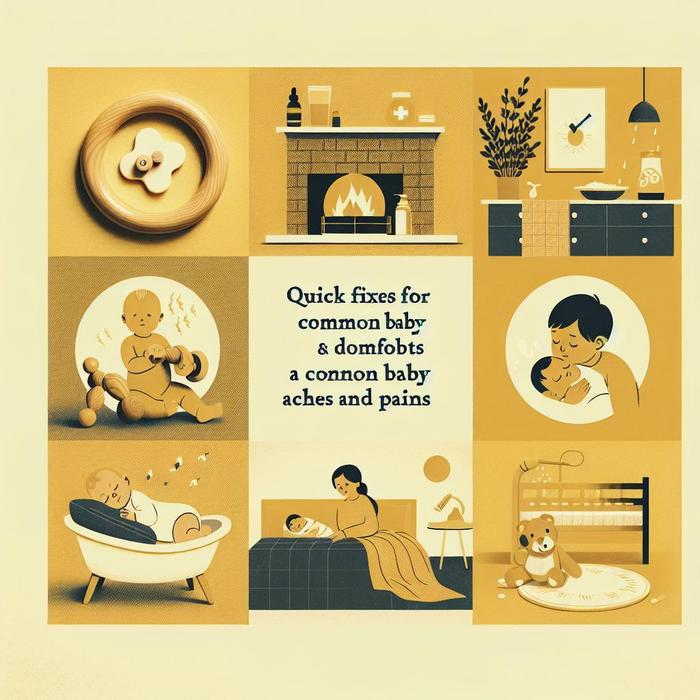Understanding Your Baby’s Discomfort
Every parent knows that having a baby is a joyous experience, but it can also be challenging. One of the most perplexing issues parents face is understanding why their baby is upset. Often, the culprit is baby aches and discomfort, which can be difficult to diagnose and manage. This blog post aims to offer some clarity on this subject, providing parents with effective infant pain solutions and methods for easing baby discomfort.
Baby Aches and Their Causes
The first step towards relieving baby aches is understanding the potential causes. Like adults, babies experience a variety of physical ailments that can cause discomfort. Here are the usual suspects:
- Teething: As your baby’s teeth start to emerge, they might experience some discomfort. Symptoms of teething usually include drooling, chewing on their fingers, and fussiness.
- Growth Spurts: Rapid growth can lead to growing pains, especially in the legs and arms.
- Gas: Babies often swallow air while feeding, which can cause gas pains.
- Common Cold: A cold can cause discomfort in the form of a runny nose, congestion, coughing, and a mild fever.
Identifying Signs of Discomfort in Your Baby
Since babies can’t communicate verbally, parents must be observant and identify signs of distress. Unusual crying, restlessness, changes in eating habits, and disturbed sleep can all indicate that your baby is experiencing discomfort. Recognizing these signs is key to providing prompt baby aches relief.
Easing Baby Discomfort: Practical Solutions
While some discomforts may require a visit to the pediatrician, most can be managed at home. Here are some simple, practical solutions:
- Teething Toys: These can provide a safe, soothing surface for your baby to chew on.
- Gentle Massage: A gentle massage can relax tense muscles and provide relief from growing pains.
- Burping: Burping your baby during and after feedings can help to release trapped gas.
- Humidity: Keeping your baby’s room humidified can help ease congestion caused by a cold.
According to the Mayo Clinic, understanding and responding to your baby’s cues is essential. This not only aids in their comfort but also helps strengthen the bond between parent and child.
When to Seek Medical Attention
While most baby aches can be managed at home, it’s crucial to consult a healthcare professional if symptoms persist or worsen. Situations that warrant immediate medical attention include a high fever, persistent crying, lethargy, or refusal to feed. Remember, it’s always better to err on the side of caution when it comes to your baby’s health.
Takeaway: Harness Your Parental Instincts
Parenting can feel like navigating an unknown terrain, especially when your baby is in discomfort. Don’t be disheartened, though. It’s crucial to remember that you, as a parent, are equipped with a powerful tool – your instinct. Trust this instinct, combined with the information in this blog post, to recognize and respond to your baby’s discomfort effectively.
For further reading, check out these Bottle Wizard articles on managing breastfeeding on demand and encouraging crawling, which can help you ensure your baby’s comfort and happiness.
Remember, it’s the little steps every day that lead to big differences in your baby’s overall comfort and wellbeing.
Other Common Causes of a Baby’s Discomfort
Besides teething, gas, and common cold, your baby can experience discomfort due to several other reasons. Here are some additional causes to consider:
- Colic: According to Healthy Children Organization, colic could be another potential reason for discomfort. Typically beginning a few weeks after birth, colic is characterised by episodes of inconsolable crying and fussiness.
- Ear Infections: Babies are prone to ear infections, which can produce symptoms like fever, trouble sleeping, or pulling at the ear.
- Diaper Rash: A rash in the diaper area can cause significant distress and discomfort.
Taking Care of the Baby’s Mother: Managing Discomfort during Pregnancy
In the crucial journey of parenthood, it’s not just the baby who requires care and attention. The mother, especially during pregnancy, may experience discomfort too. Here are some tips from Johns Hopkins Medicine and Cleveland Clinic to help expectant mothers manage pain and discomfort effectively:
- Exercise Regularly: Simple exercises like walking and stretching can help alleviate back pain and contribute to the overall well-being during pregnancy.
- Belly Bands: These specially designed bands provide extra support to your growing belly, helping reduce discomfort.
- Prenatal Massage: A professionally administered prenatal massage can provide relief from leg cramps, lower back pain, and swelling.
- Eat a Balanced Diet: Maintain a healthy diet rich in fiber to prevent constipation and improve overall health.
Understanding Baby’s Discomfort – A Journey, Not a Destination
Every baby is different and so are their reactions to discomfort. Sometimes, diagnosing and treating their discomfort can feel like an enigma. However, gaining insight into their particular signals and symptoms can lead to swift and effective solutions.
Most importantly, keep in mind your parental connection with your baby. This bond is nature’s way of aiding you to decode your baby’s needs. Trust this bond, combined with the information and resources shared in this blog post and medical advice when necessary, to help you navigate your parenting journey.
As you enhance your skills and responses to dealing with baby discomfort, you are not only improving your baby’s immediate comfort but also paving the way for a healthier and happier future.
Continue this journey of understanding and caring for your baby with the help of supportive resources from Bottle Wizard, Healthy Children Organization, Cleveland Clinic and Johns Hopkins Medicine.







